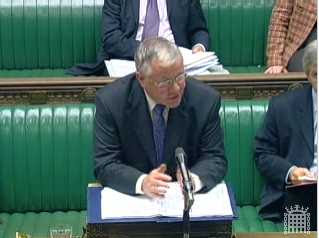 One thing that struck me in the article by Chris Dillow in yesterday's Times - which was one of the reasons I reviewed it - was his comment, "The larger and more authoritarian the organisation, the better the chance that its top decision-makers will be operating in purely imaginary worlds."
One thing that struck me in the article by Chris Dillow in yesterday's Times - which was one of the reasons I reviewed it - was his comment, "The larger and more authoritarian the organisation, the better the chance that its top decision-makers will be operating in purely imaginary worlds."If we take that to mean that top decision-makers have completely lost touch with reality, then I am absolutely at one with Dillow, certainly as regards the performance of the officials at the MoD's "Specialist and Utility Vehicles Integrated Project Team".
 At a time when the infantry in Iraq and Afghanistan is being equipped, as fast as is humanly possible with up-armoured vehicles – including the famed Mastiff (pictured) – in order to protect against the increasing threat from IEDs – what else can explain their bizarre decision to spend around £415,000 each (a cool £7.5 million) on 18 Swiss-built Bucher Duro Disposal and Search Explosives Ordnance Disposal vehicles for deployment in these theatres?
At a time when the infantry in Iraq and Afghanistan is being equipped, as fast as is humanly possible with up-armoured vehicles – including the famed Mastiff (pictured) – in order to protect against the increasing threat from IEDs – what else can explain their bizarre decision to spend around £415,000 each (a cool £7.5 million) on 18 Swiss-built Bucher Duro Disposal and Search Explosives Ordnance Disposal vehicles for deployment in these theatres?Called "Tellar" by the Army (pictured above), the type was recently described in a gushing puff on the MoD website as, "a state-of-the-art vehicle to help munitions disposal personnel move around safely on operations". They are anything but.
 These vehicles are supposed to be designed to attend sites where suspected IEDs have been detected, or where there have been explosions and secondaries are suspected, for which purpose you would expect the very best available protection, especially as bomb disposal officers are often specifically targeted by insurgents.
These vehicles are supposed to be designed to attend sites where suspected IEDs have been detected, or where there have been explosions and secondaries are suspected, for which purpose you would expect the very best available protection, especially as bomb disposal officers are often specifically targeted by insurgents.But not a bit of it. Not only does the vehicle share with the Pinzguaer Vector, the positioning of the driver over the front wheel – in an optimum position to ensure maximum vulnerability in the event of a mine strike or explosion by a buried IED - the vehicles are devoid of any effective armour, being fitted only with "a level of riot protection".
 By contrast, the USMC and the US Army provide their bomb disposal teams with the Force Protection Joint Explosive Ordnance Disposal Rapid Response Vehicle (JERRV), otherwise known as the Cougar, on which the Mastiff is based.
By contrast, the USMC and the US Army provide their bomb disposal teams with the Force Protection Joint Explosive Ordnance Disposal Rapid Response Vehicle (JERRV), otherwise known as the Cougar, on which the Mastiff is based.Not only is this vehicle actually cheaper than the Tellar (at about £250,000), it is designed specifically to afford protection from IEDs, in testament of which, Cougars have now taken over 2,000 IED hits, with no deaths amongst their crews.
Unfortunately, the "Tellar" is not the Specialist and Utility Vehicles Integrated Project Team's only venture into fantasy. Its input also gave us the Pinzgauer Vector (aka "coffin on wheels") and the absurdly expensive Panther - which is too unsafe to use in either Iraq or Afghanistan.
 Worryingly, this is the same team that is going to have a key part in selecting the vehicles for the FRES project. On current form, the design/selection team is unlikely to have learned the lessons that the current campaigns have yielded and, if its thinking on the "Tellar" is any guide, this is a group which is actually incapable of learning lessons.
Worryingly, this is the same team that is going to have a key part in selecting the vehicles for the FRES project. On current form, the design/selection team is unlikely to have learned the lessons that the current campaigns have yielded and, if its thinking on the "Tellar" is any guide, this is a group which is actually incapable of learning lessons.And it is not as if their choices do not kill people – they do. Apart from the debacle with the "Snatch" Land Rovers, it is germane to note that the soldier whose death was so graphically recounted by Telegraph yesterday, was riding in a Viking APC when it was hit by a mine (or buried IED).
 Yet this was the vehicle that was deployed in a blaze of publicity last year and then given sustained publicity by the MoD.
Yet this was the vehicle that was deployed in a blaze of publicity last year and then given sustained publicity by the MoD.Although we were expressing our reservations about lack of mine protection, the media followed the MoD line with their own gushing puffs about the new kit (as they always do). Now, a man is dead because – as was self evident at the time of its introduction – the vehicle had wholly inadequate mine protection.
Returning to Chris Dillow's article, one can thus only agree with his thesis and remark that the officials who are entrusted with supplying our soldiers with kit are indeed living in one of his purely imaginary worlds. It is perhaps appropriate that their main energies should be devoted to FRES, a purely fantasy project.
COMMENT THREAD






































